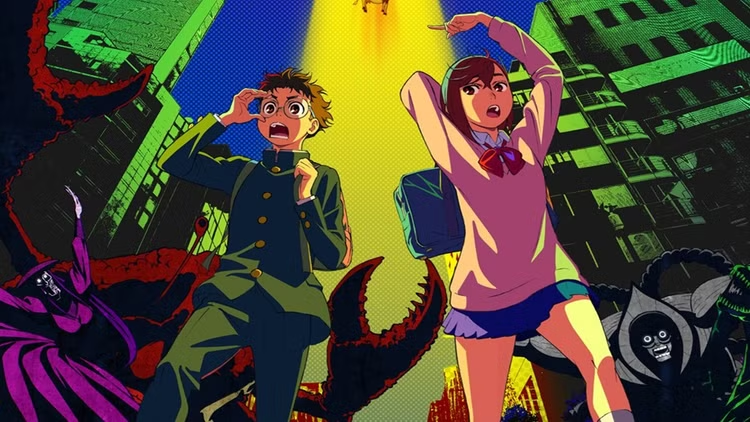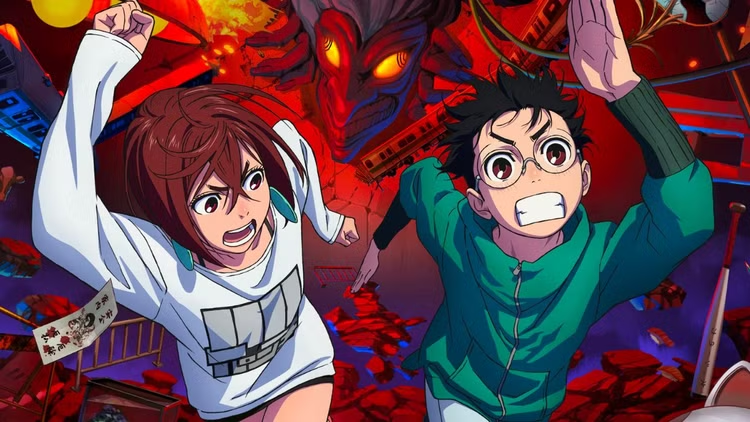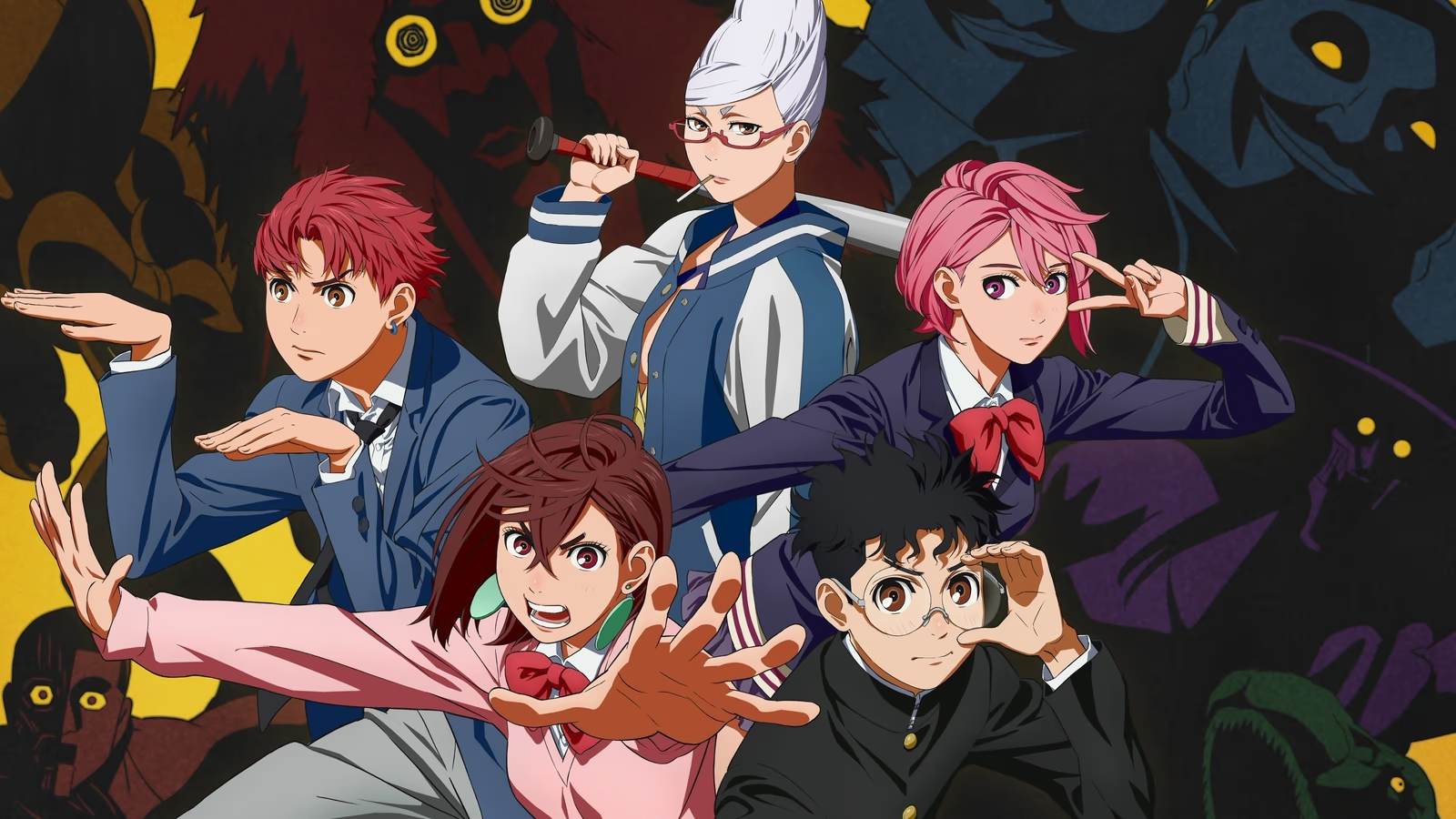In the ever-evolving landscape of manga and anime, few series have managed to blend the paranormal and scientific with such creative abandon as Dandadan. Created by Yukinobu Tatsu, this breakout hit marries UFO encounters with ghostly hauntings in a world where the impossible becomes everyday reality for its teenage protagonists. What makes Dandadan particularly fascinating is how it handles the science vs. supernatural in its storytelling – neither dismissing nor fully endorsing either perspective, but instead creating a universe where both aliens and spirits coexist in chaotic harmony.
Dandadan’s Premise: Aliens, Ghosts, and Teenage Chaos

At its core, Dandadan follows two high school students with opposing beliefs: Momo Ayase, who believes in ghosts but dismisses aliens as nonsense, and Ken Takakura (nicknamed “Okarun”), who believes in aliens but thinks ghosts are ridiculous. Their friendly argument leads to a bet where each visits a location associated with the other’s belief – Momo to an abandoned hospital rumored to host UFO sightings, and Okarun to a tunnel allegedly haunted by the spirit of a woman.
What follows shatters both teenagers’ worldviews – Momo encounters genuine aliens (though not the kind Okarun expected), while Okarun is possessed by the spirit of a legendary entity called Turbo Granny. From this premise springs a narrative where science fiction and supernatural horror not only coexist but constantly intertwine, forcing the characters to reckon with a reality far more complex than either initially imagined.
This dual-track narrative establishes the science vs. supernatural in Dandadan as more than just a stylistic choice – it’s the fundamental engine driving the story forward. Neither perspective is shown to be completely right or wrong; instead, both exist in a strange equilibrium where each explains different aspects of the world’s mysteries.
The Symbolism of UFOs and Ghosts
The contrast between aliens and ghosts in Dandadan carries significant symbolic weight that resonates with modern audiences. UFOs and aliens traditionally represent scientific mystery – the unknown that might be explained through technology and rational investigation. They embody humanity’s curiosity about the cosmos and our place within it, often tied to conspiracy theories and government cover-ups. In Dandadan, aliens represent the scientific unknown – entities that can potentially be understood through observation and logic.
Ghosts, conversely, symbolize the supernatural unknown – phenomena that defy scientific explanation and connect to spiritual beliefs, cultural traditions, and primal fears of death. Spirits in Dandadan are tied to human emotions, unfinished business, and the persistence of consciousness beyond physical death. They represent the aspects of existence that science struggles to quantify or explain.
By placing these forces in direct conversation, Dandadan explores the tension between empirical knowledge and spiritual understanding. The series suggests that limiting oneself to either perspective creates blind spots – much as Momo and Okarun initially missed half the picture by dismissing each other’s beliefs.
How Science and Supernatural Interact in Dandadan’s Worldbuilding
Dandadan‘s worldbuilding thrives on the intersection of scientific and supernatural elements. The series establishes distinct “rules” for both aliens and spirits while showing how these seemingly separate forces actually overlap and interact.
Aliens in the Dandadan universe often possess advanced technology and physical forms that, while bizarre, follow some form of biological logic. They represent extraterrestrial evolution and intelligence that developed along different paths than Earth’s life. Their abilities typically stem from physical adaptations or technological advantages rather than metaphysical powers.
Spirits, meanwhile, operate on emotional and metaphysical rules. Their powers often relate to their manner of death, unresolved feelings, or cultural beliefs about the afterlife. They can possess humans, manipulate emotions, and break physical laws in ways that defy scientific explanation.
What makes Dandadan‘s worldbuilding particularly interesting is how these forces interact. When alien technology confronts spiritual possession, or when psychic powers face off against extraterrestrial biology, the results are unpredictable and often spectacular. The series consistently shows that neither science nor supernatural forces hold complete dominance – each has strengths and vulnerabilities the other can exploit or complement.
This interaction creates a world where distinctions blur. Are psychic powers scientific or supernatural? Do aliens with spiritual awareness straddle both categories? The manga refuses simple categorization, instead reveling in the messy gray area where these forces meet.
Character Perspectives: Believers, Skeptics, Fighters
The evolution of Momo and Okarun’s perspectives forms the emotional core of how science vs. supernatural in Dandadan plays out on a character level. Both begin as believers in one side and skeptics of the other, only to have their worldviews forcibly expanded through direct experience.
Momo’s psychic powers and spiritual awareness initially place her firmly in the supernatural camp. Her family legacy of spiritual power gives her confidence in the existence of ghosts and spirits. However, her encounters with aliens force her to acknowledge the validity of Okarun’s perspective as well. Her character growth includes learning to apply her supernatural abilities to scientific threats.
Okarun’s obsession with aliens and UFOs represents a more science-fiction oriented worldview, though one still on the fringe of mainstream science. His possession by Turbo Granny thrusts him into the supernatural world he once dismissed. As he learns to control and coexist with this spiritual entity, he embodies the series’ theme of reconciliation between opposing forces.
Supporting characters further expand this spectrum of perspectives. Some align more with scientific explanations, others with supernatural beliefs, and many occupy various points in between. Their interactions highlight how these viewpoints can complement or conflict with one another, demonstrating that understanding both sides provides the most complete picture of reality.
Is There a Winner? Dandadan’s Thematic Neutrality
One of the most refreshing aspects of Dandadan is that it doesn’t ultimately declare either science or the supernatural as the “correct” perspective. Instead, the manga maintains thematic neutrality by showing both forces as equally valid parts of its universe.
The series treats both aliens and spirits with a mixture of terror and absurdity. UFOs can be both awe-inspiring and ridiculous; ghosts can be both horrifying and comical. This balanced approach prevents the narrative from tipping too far in either direction, instead suggesting that both perspectives have their place in understanding the world’s mysteries.
This neutrality extends to how powers and conflicts are resolved in the story. Sometimes scientific approaches prove most effective against supernatural threats; other times, spiritual understanding helps counter alien technology. The characters most successful at navigating this dangerous world are those who integrate both perspectives rather than clinging exclusively to one.
By refusing to declare a “winner” in the science vs. supernatural in Dandadan, the series invites readers to consider the value of multiple perspectives when confronting the unknown – an approach that resonates with contemporary discussions about the limitations of pure rationalism and the potential value of traditional knowledge systems.
Comparing Dandadan to Other Genre-Bending Works
Dandadan‘s approach to blending science fiction and supernatural horror distinguishes it from other works that attempt similar genre fusion. Unlike series like Bleach, which primarily focuses on spiritual entities with science fiction elements as occasional additions, or UFO Baby, which uses aliens mainly as a romantic comedy device, Dandadan gives equal narrative weight to both elements.
Perhaps the closest spiritual relative to Dandadan is Mob Psycho 100, which similarly blends psychic powers with coming-of-age themes. However, even Mob Psycho leans more heavily toward the supernatural side of the equation, whereas Dandadan maintains its balance between ghostly possession and alien abduction with remarkable consistency.
What makes Dandadan‘s approach feel fresh is its refusal to hierarchize these elements. Neither science fiction nor supernatural horror serves as merely a backdrop for the other; instead, they constantly intersect and influence each other. This integration, combined with the manga’s distinctive visual style and offbeat humor, creates something that feels genuinely innovative despite drawing from familiar genre elements.
Final Thoughts: Why the Science vs. Supernatural Theme Resonates

The science vs. supernatural in Dandadan resonates with modern audiences because it reflects our own complex relationship with different ways of understanding reality. In a world where scientific advancement continues at breakneck speed yet many people still find meaning in spiritual traditions and unexplained phenomena, Dandadan‘s refusal to dismiss either perspective feels honest and inclusive.
By following characters who must reconcile these seemingly contradictory worldviews, the manga speaks to anyone who has ever felt caught between rational explanation and inexplicable experience. It validates both the scientific impulse to categorize and understand through observation and the spiritual impulse to seek meaning beyond the material world.
Dandadan ultimately suggests that the most complete understanding comes not from choosing between science and the supernatural, but from recognizing how both perspectives can illuminate different aspects of existence. In its weird, wild, and wonderful way, the series offers a surprisingly nuanced take on epistemological questions that have challenged humanity for generations – all while delivering spectacular action sequences and genuinely heartfelt character moments.
FAQs About Science vs. Supernatural in Dandadan
-
Is Dandadan more about science fiction or supernatural horror?
Dandadan gives equal weight to both science fiction and supernatural horror elements. The series deliberately balances alien encounters with ghostly hauntings, refusing to prioritize either perspective. This dual focus is central to the manga’s identity and thematic concerns.
-
What do the aliens in Dandadan represent?
The aliens in Dandadan represent scientific mystery and the unknown reaches of the universe. They embody possibilities beyond Earth-bound understanding but still within the realm of physical reality. They also serve as foils to the supernatural entities, offering a different kind of threat that requires different solutions.
-
Are ghosts and aliens connected in Dandadan?
While ghosts and aliens represent different forces in Dandadan, the series suggests some connections between them. Both exist in realms beyond normal human experience, and sometimes their abilities or origins overlap in unexpected ways. The manga implies that a complete understanding of one might require knowledge of the other.
-
How does Dandadan balance its sci-fi and supernatural elements?
Dandadan balances these elements by giving both equal narrative importance and showing how they interact within its world. The manga alternates between alien and ghost encounters while gradually revealing connections between them. Additionally, its approach to both – mixing horror with absurdist humor – creates a consistent tone despite the genre variations.
-
Do Momo and Okarun switch beliefs during the story?
Rather than completely switching beliefs, Momo and Okarun expand their worldviews to incorporate what they previously dismissed. Momo comes to accept the reality of aliens while maintaining her belief in ghosts, and Okarun embraces the supernatural reality of his possession while continuing his interest in extraterrestrials. This represents growth rather than conversion.


Leave a Reply